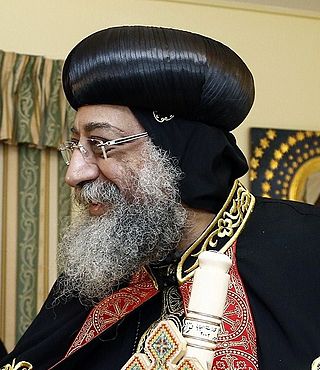Related Research Articles

The Coptic Orthodox Church, also known as the Coptic Orthodox Patriarchate of Alexandria, is an Oriental Orthodox Christian church based in Egypt, in Africa and the Middle East. The head of the church and the See of Alexandria is the pope of Alexandria on the Holy Apostolic See of Saint Mark, who also carries the title of Father of fathers, Shepherd of shepherds, Ecumenical Judge and the 13th among the Apostles. The See of Alexandria is titular. The Coptic pope presides from Saint Mark's Coptic Orthodox Cathedral in the Abbassia District in Cairo. The church follows the Coptic Rite for its liturgy, prayer and devotional patrimony. Christians in Egypt total about 10 million people, and Coptic Christians make up Egypt's largest and most significant minority population, and the largest population of Christians in the Middle East and North Africa (MENA).

Pope Shenouda III was the 117th Pope of Alexandria and Patriarch of the See of St. Mark. His papacy lasted 40 years, 4 months, and 4 days, from 14 November 1971 until his death.
Pope Avilius of Alexandria, was the 3rd Patriarch of Alexandria.
Saint Agathon of Alexandria, was the 39th Pope of Alexandria & Patriarch of the See of St. Mark. St. Agathon was a disciple of Pope Benjamin I, the 38th Pope of the Coptic Orthodox Church so when Pope Benjamin had to flee to avoid persecution by the Chalcedonians, Agathon remained and led the church.

Michael I was the 46th Coptic Pope and Patriarch of Alexandria from 743 to 767.

The pope, also known as the Bishop of Alexandria or the Coptic pope, is the leader of the Coptic Orthodox Church, with ancient Christian roots in Egypt. The primacy in the Coptic pope, similar to the Catholic belief in the Bishop of Rome as successor to Saint Peter, is rooted in his role as successor to Saint Mark. The current holder of this position is Pope Tawadros II, who was selected as the 118th pope on November 18, 2012.
Coptic pronunciation reform, since 1850, has resulted in two major shifts in the liturgical pronunciation of Bohairic, the dialect of Coptic used as the language of the Coptic Orthodox Church. Since Coptic had ceased to be spoken as a mother-tongue by this time, a change in education changed how the language was spoken. The two traditions of pronunciation in contemporary use arise from two successive reforms in the 19th and 20th centuries:

The Coptic Orthodox Church of Alexandria has several churches in Great Britain and Ireland under the jurisdiction of four diocesan bishops.
Iris Habib Elmasry was a prominent Coptic Historian (1910–1994).
Matta El Meskeen, born Youssef Iskandar, was a Coptic Orthodox monk. He was the key figure in the revival of Coptic monasticism, a movement which began in 1969 when he was appointed to the Monastery of St Macarius in the Wadi El Natrun in Egypt. By the time of his death the community had grown from 6 aged monks to 130 monks, and as many other monasteries were revived, new ones also began to open. He was twice nominated to become Coptic Pope, but was not chosen in either case.
The Institute of Coptic Studies was founded in 1954 by the Coptic Orthodox Church of Alexandria. It is based in Cairo.

Coptic history is the part of the history of Egypt that begins with the introduction of Christianity in Egypt in the 1st century AD during the Roman period, and covers the history of the Copts to the present day. Many of the historic items related to Coptic Christianity are on display in many museums around the world and a large number is in the Coptic Museum in Coptic Cairo.
Aziz Suryal Atiya was an Egyptian Coptologist who was a Coptic historian and scholar and an expert in Islamic and Crusades studies.
Coptic Australians are Australians of Coptic descent or persons of Coptic descent residing in Australia. According to the 2011 census, there were 24,693 Copts in Australia, mostly members of the Coptic Orthodox Church. The Coptic population within Australia is estimated to be between 70,000 and 100,000 people.
Fayek Matta Ishak was an Egyptian Canadian coptologist, author and scholar. He was the founder and editor-in-chief of Coptologia Publications, a journal into Coptic Thought and Spirituality. He was also the author and publisher of the first English translation of the Liturgy of St. Basil into Jamesian English (1611) from Arabic at the request of Pope Shenouda III of Alexandria.
There are no original works of philosophy in the Coptic language. All surviving philosophical passages in Coptic are of Greek origin and many are anonymous. Mostly they deal with ethics and are treated like wisdom literature. Only a few texts have been edited and published.
George Habib Bebawi was a Coptic Egyptian-American theologian, Biblical scholar and Patristics scholar.
Basil IV,, was the 20th Metropolitan of the Holy and Great City of Our Lord, Jerusalem, and Archbishop of the Holy and Ancient Archdiocese of Jerusalem, all Palestine and the Near East, from 1959, until his death in 1991.
Hugh Gerard Evelyn-White was a classicist, egyptologist, coptologist and archaeologist. In 1907 he graduated with a degree in classics from Wadham College. He is noted for his many translations of ancient Greek works, most notable being those of Hesiod and the Homeric hymns. He served in the British Army in the Middle East during WWI as an officer but was invalided out in 1917. He worked on the excavations in Egypt and he returned to England in 1922 to work at as a lecturer at the University of Leeds but took his own life in 1924. He shot himself in a taxi after the preceding suicide of a romantic interest.
References
- Claremont Coptic Encyclopedia at the Claremont Colleges Digital Library